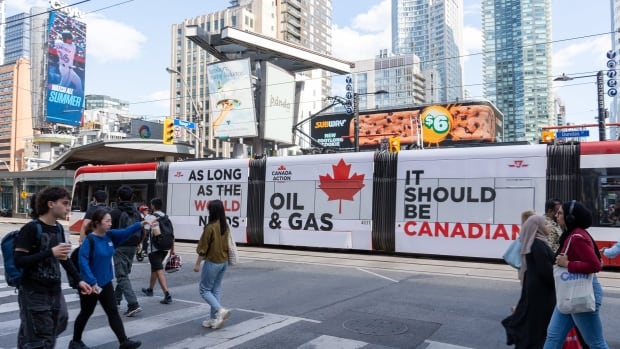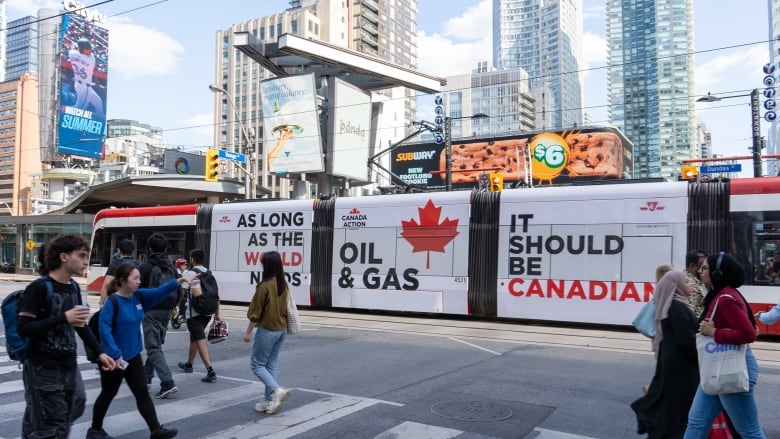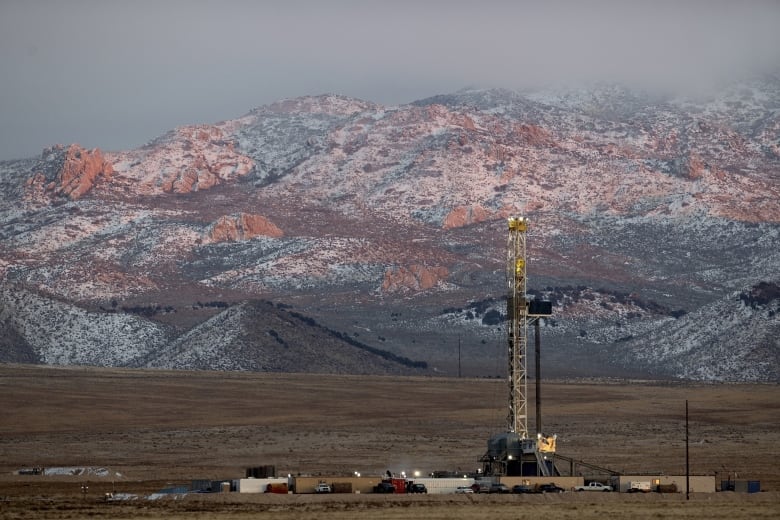
Our planet is changing. So is our journalism. Keep up with the latest news on our Climate and Environment page.
Sign up here to get this newsletter in your inbox every Thursday.
This week:
- Canada’s two largest cities are cracking down on fossil fuel ads
- Cones for caribou
- Power-hungry AI could help grow clean energy
Canada’s two largest cities are cracking down on fossil fuel ads. What’s next?

Montreal and Toronto have both taken steps to limit advertising for oil and gas on their subways, buses and streetcars. And this week, Toronto city council passed a motion to restrict fossil fuel advertising on city property.
Melissa Lem, president of the Canadian Association of Physicians for the Environment (CAPE), called Toronto’s decision Thursday a “landmark win.”
“This bold move signals the end of unchecked fossil fuel advertising and positions Toronto at the forefront of a global shift,” said Lem, a family doctor in Vancouver.
She called the moves by Toronto and Montreal early but “significant” steps toward tighter restrictions countrywide.
“We want to take a stand and — even if it’s a lonely stand at first — show the rest of the country that we don’t want more harmful advertising driven by fossil fuel companies.”
Lem’s group, which represents 700,000 health-care workers in Canada, has been pushing for advertising restrictions similar to those on tobacco products, arguing the burning of fossil fuels has significant impacts on health, from polluting to the broader impacts of climate change.
The Montreal transit authority, known as the Société de transport de Montréal (STM) has new guidelines that will limit — but not outright ban — oil and gas-related advertisements on its metros and buses. The ads must be reviewed to ensure they are evidence-based, and don’t amount to greenwashing — a blanket term for misleading statements about an industry or product’s environmental record.
“We wish to contribute to the financing of public transit in a responsible manner, which is why it is so important to establish clear guidelines against greenwashing practices in advertising,” Charles Gratton, a representative from Transgesco, which handles advertising for STM, said in an emailed statement.
Similarly, the Toronto Transit Commission (TTC) adopted a motion last month banning “misleading” fossil fuel advocacy advertising.
The motion singles out Pathways Alliance, which represents major oilsands producers, and Canada Action, another fossil fuel lobby group — both of which have run advertisements on Toronto streetcars. Greenpeace filed a complaint with the Competition Bureau over the Pathways ad, which proclaimed its “net-zero plan is in motion.”
Going forward, any proposed advertising by these groups will be put to a review to make sure they follow the Canadian Code of Advertising Standards, which states that “advertisements must not distort the true meaning of statements made by professionals or scientific authorities.”
Dianne Saxe, a Toronto city councillor who introduced the TTC motion, said the changes are an attempt to put an end to greenwashing, which is especially harmful when the message is conveyed on public transit.
“It undermines the brand of the transit agency itself,” Saxe told the National Observer.
Fossil fuel groups were quick to denounce the TTC motion.
Cody Battershill, founder of Canada Action, said the motion was an attempt to “further divide the public on important issues of public interest around Canada’s natural resource abundance.”
Kendall Dilling, president of Pathways Alliance, said his group wants to take part in “important conversations about the environment and resource development.”
“We remain committed to communicating, including use of advertising,” he said.
Streetcars, buses and subways aren’t the only spaces where fossil fuel groups are being subjected to greater restrictions.
The Liberal government introduced new rules aimed at cracking down on greenwashing earlier this year, prompting pushback from fossil fuel industry groups — and some of them to strip their websites of their environmental commitments. The NDP wants to go further, banning misleading fossil fuel advertising altogether.
United Nations Secretary General Antonio Guterres put the issue in the international spotlight this summer, in a major speech that gave ammunition to critics who have been calling for tighter restrictions.
“Many in the fossil fuel industry have shamelessly greenwashed, even as they have sought to delay climate action — with lobbying, legal threats and massive ad campaigns,” Guterres said.
— Benjamin Shingler

Old issues of What on Earth? are here. The CBC News climate page is here.
Check out our podcast and radio show. In our newest episode: When natural disasters hit home, knowing your neighbours could be a lifeline. Edmonton is leading the way in creating climate resilience on a hyperlocal level. We hear how something as simple as a neighbourhood bonfire can build support networks, and mobilize communities to fight climate change.
What On Earth19:34A climate fix that starts with ‘hi-diddly-ho neighborino’
When natural disasters hit home, knowing your neighbours could be a lifeline. Edmonton is leading the way in creating climate resilience on a hyperlocal level. We hear how something as simple as a neighbourhood bonfire can build support networks, and mobilize communities to fight climate change.
What On Earth drops new podcast episodes every Wednesday and Saturday. You can find them on your favourite podcast app, or on demand at CBC Listen. The radio show airs Sundays at 11 a.m., 11:30 a.m. in Newfoundland and Labrador.
Reader feedback
Last week, Anand Ram wrote about seniors protesting for more action on climate change.
Toni O’Brien responded: “I am a senior. From very early on in my childhood, we were taught to conserve — everything…. I support seniors protesting, pushing for change but where I think we are weak is that we — as in every single one of us — need to have environmental principles at the top of our choices for everyday living, 24/7. It bothers me that I belong to a generation who believes we ‘deserve’ to be able to travel, we ‘deserve’ to be able to afford luxuries without thought of how that trip or luxury might affect our environment…. Whether we are cooking a meal, throwing out a worn-out bed sheet or taking our children to school, there is always something that can be done to reduce, reuse and last choice, recycle. We can make a difference because we must. Government must help. We must do.”
Peter Prontzos had a different response: “While it is certainly true that many seniors are feeling ‘guilty’ about the climate crisis, such a feeling is not only unfair, it is also dangerous. The reason is pretty simple — the main causes of the environmental cliff that we are facing have nothing to do with individuals and everything to do with corporate greed. So yes, we should be more conscious consumers, but the most important thing that individuals can do is to work together to create the public movements that could take on the lies and the power of big business, and by doing so actually change policies before it’s too late.”
Alma Hyslop had a few thoughts on last week’s The Big Picture: “Your article on the dangers of ultra fine particles (UFPs) missed a common source: residential wood burning. 1,000 premature deaths per year in Toronto and Montreal? Cancer, heart disease, diabetes, dementia? Why not ask what living in a fog of wood smoke does to the health of those in remote and Indigenous communities? Also ask why we voluntarily pollute our homes and neighbourhoods by burning wood recreationally in fireplaces and backyard fire pits.”
She also suggested that the article on the coal phaseout in the U.K. “contains an embedded piece of greenwashing” by not mentioning that a “significant portion of the U.K.’s ‘renewable energy’ comes from burning biomass” in the form of wood pellets.
It’s true that biomass makes up about nine per cent of electricity generation in the U.K. However, it isn’t considered by the country’s electrical network to be renewable energy.
Write us at [email protected].
Have a compelling personal story about climate change you want to share with CBC News? Pitch a First Person column here.




The Big Picture: Cones for caribou
Noel Football is plucking cones from the boughs as part of an ambitious, multi-year tree-planting project that is unfolding in the region a year after it burned extensively by wildfire. The seeds will be harvested from the cones, grown into saplings in southern nurseries, and brought back for planting.
The Tłı̨chǫ government signed an agreement with Tree Canada and Let’s Plant Trees to plant one million trees around Behchokǫ̀ over the next two years. The hope is the new trees will restore ecosystems, create jobs, and bring back boreal caribou — a threatened species that the Tłı̨chǫ people rely on.
The project has harvested seeds from black spruce, tamarack, aspen and birch trees as well — and some of them will be planted strategically to protect Behchokǫ̀ from fire in the future.
You can read the full story here.
— Liny Lamberink
Hot and bothered: Provocative ideas from around the web
-
Four years ago, we looked at how those little plastic stickers on fruits and veggies can contaminate compost and contribute to climate change. Now, finally, produce producers around the world have agreed to transition to certified compostable produce stickers.
-
Speaking of waste, did you know October is Circular Economy Month in Canada? Communities are hosting events such as repair cafes, pickling and jam-making workshops and recycling collection for items that can’t go in your blue bin at home, and the Circular Innovation Council offers “circular” tips for a sustainable Thanksgiving.
-
Proponents of liquefied natural gas (LNG) have argued it could be good for the climate if it replaces coal. But a new study finds LNG actually generates 30 per cent more emissions than coal because drilling, moving, cooling and shipping gas uses so much energy.
-
Bertrand Piccard, the man who flew a solar plane around the world, says he has found 1,650 ways to turn a profit while decarbonizing, He spoke to WIRED about what kinds of solutions work, and how to implement them.
-
Portugal is launching a new national rail pass for just 20 euros ($30) per month as an “investment in the environment.” Some other European countries offer similar cheap rail passes.




How power-hungry AI could help fuel growth in alternative energy


Using AI can feel like watching a magic trick.
Ask ChatGPT for a photo and out it comes, no matter how elaborate or goofy the request.
But behind the scenes are servers furiously working to power the technology — and using a lot of energy to do it.
According to some estimates, the average ChatGPT query takes about 10 times more power than a Google search, and generating an image takes about as much as charging a smartphone.
Depending where that power comes from, some warn the growth of AI could mean a massive spike in fossil fuel-related emissions. According to investment bank Goldman Sachs, carbon dioxide emissions from powering data centres could more than double between 2022 and 2030.
But some experts say the news isn’t all bad, and that growing demand for energy to power AI is also fuelling development of alternative forms of energy — from wind and solar to geothermal and nuclear — that could help propel the energy transition.
Ed Crooks, vice-chair for the Americas with Wood Mackenzie said tech companies want power to be cheap, reliable and as environmentally friendly as possible given many of these companies’ climate pledges.
In the near term, he said, the easiest way to hit the first two objectives is often with gas-fired power plants. And in the U.S., there’s lately been a major surge in plans to build new plants.
“[This] does have big problems because clearly power from a gas-fired power plant is not carbon-free and these companies all aim to be carbon-free,” he said on the sidelines of last week’s Energy Disruptors conference in Calgary.
The varying approaches to how AI companies might meet their massive demand for energy are evident in Canada, where the majority of data centres so far have been in provinces with abundant hydroelectricity. According to the Canada Energy Regulator, there are 105 in Ontario, 57 in Quebec and 35 in British Columbia.
Alberta, which relies on natural gas for most of its power, has 22 data centres, the regulator says. However, the province has been busy promoting itself as an ideal place to set up more, and industry interest is growing.
Using carbon capture facilities in tandem with natural gas plants is one way to reduce their carbon impact, though this can add costs when developing a project.
“It costs more to generate power [while using carbon capture]. Whether or not that’s effective from a business point of view for the industry is a question,” said Warren Mabee, director of the Institute for Energy and Environmental Policy at Queen’s University, in an interview.
But as tech companies scramble to get reliable sources of power up and running as soon as possible, they’ve also put big money into renewable and alternative sources of energy, even those that have high up-front capital costs, like geothermal.
For example, Google has built a first-of-its-kind geothermal power project in Nevada to power its nearby data centres, and expressed interest in using small modular reactors (SMRs) for a similar purpose.
Amazon has recently become the world’s top corporate buyer of solar and wind energy.
And Microsoft recently made headlines for announcing it had signed a power-purchase agreement that would restart the Three Mile Island nuclear power plant in Pennsylvania.
“We are advocating for more nuclear across the system,” said Jim Collins, who is in charge of Microsoft’s data centre energy strategy, speaking onstage at the energy conference.
As these tech companies build out alternative energy projects at scale, there’s hope that they can work out some of the kinks and drive costs down, making it easier for other companies to follow suit, said Keaton Horner, director of analytics with Orennia, a Calgary-based analytics company that helps companies transition to renewable and alternative energy sources.
“We could actually see folks like Microsoft start to invest heavily in these newer technology types of energy sources, get a few of them built, we learn along the way as we get more capacity added,” said Horner, pointing to SMRs as another example.
“Five to 10 years from now, those could be actually just cost-competitive with traditional sources of energy as we know them today.”
— Paula Duhatschek
Stay in touch!
Thanks for reading. Are there issues you’d like us to cover? Questions you want answered? Do you just want to share a kind word? We’d love to hear from you. Email us at [email protected].
Sign up here to get What on Earth? in your inbox every Thursday.
Editors: Emily Chung and Hannah Hoag | Logo design: Sködt McNalty